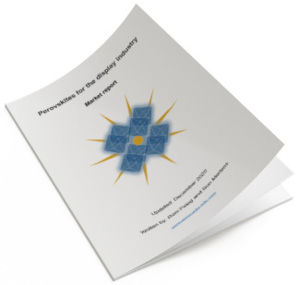What are perovskites?
Perovskite is a calcium titanium oxide mineral, with the chemical formula CaTiO3, discovered in the Ural Mountains of Russia by Gustav Rose in 1839 and named after Russian mineralogist Lev Perovski (1792–1856).
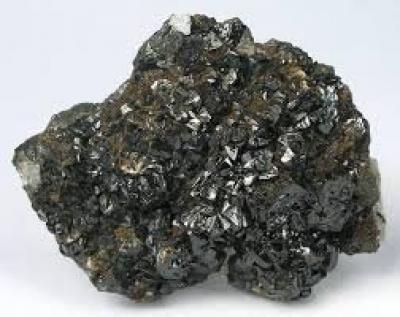
Perovskites are a class of materials with a similar structure that are easily synthesized and relatively low-cost. Perovskites are considered the future of solar cells and are also predicted to play a significant role in next-gen electric vehicle batteries, displays, sensors, lasers and much more.
Perovskites can have an impressive collection of interesting properties including “colossal magnetoresistance” - their electrical resistance changes when they are put in a magnetic field (which can be useful for microelectronics). Some Perovskites are superconductors, which means they can conduct electricity with no resistance at all. Perovskite materials exhibit many other interesting and intriguing properties. Ferroelectricity, charge ordering, spin dependent transport, high thermopower and the interplay of structural, magnetic and transport properties are commonly observed features in this family. Perovskites therefore hold exciting opportunities for physicists, chemists and material scientists.
What are LEDs?
A light-emitting diode (LED) is an electronic component that is essentially a two-lead semiconductor light source. It is a p–n junction diode that emits light upon activation by a voltage applied to the leads, which makes electrons recombine with electron holes within the device, releasing energy in the form of photons. This effect is called electroluminescence, and the color of the light is determined by the energy band gap of the chosen semiconductor.
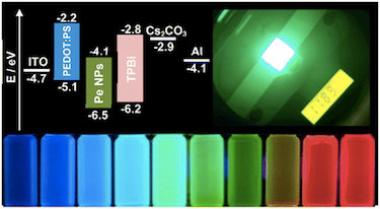
LEDs’ advantages over incandescent light sources include lower energy consumption, longer lifetime, improved physical robustness, smaller size, and faster switching. Light-emitting diodes have become ubiquitous and are found in diverse applications in the aerospace and automotive industries, as well as in advertising, traffic signals, camera flashes and much more.
LEDs meant for general room lighting currently remain more expensive than fluorescent or incandescent sources of similar output, but are significantly more energy efficient.
What can perovskites do for LEDs?
Current high-quality LEDs are based on direct bandgap semiconductors, but making these devices is no easy task because they need to be processed at high temperatures and in vacuum, which makes them rather expensive to produce in large quantities. Perovskites that are direct-bandgap semiconductors could be real alternatives to other types of direct-bandgap materials for applications like color displays, since they are cheap and easy to make and can be easily tuned to emit light of a variety of colors.
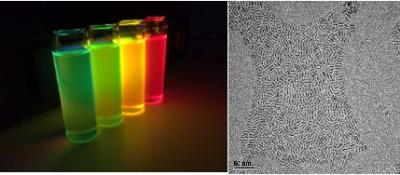
Researchers have found that organometal halide-based perovskites (a combination of lead, organics and halogens that arrange into perovskite crystal structure in the solid state) could be very suitable for making optoelectronics devices, since they can be processed in solution and do not need to be heated to high temperatures. This means that large-area films of these materials can be deposited onto a wide range of flexible or rigid substrates. The perovskites also have an optical bandgap that can be tuned in the visible to infrared regions, which makes them very promising for a range of optoelectronics applications. These materials also emit light very strongly, which makes them very suitable for making LEDs. The light emitted by the perovskites can be easily tuned, which could make them ideal for color displays and lighting, and in optical communication applications.
However, a major obstacle that perovskites will have to overcome in order to be used in LED-type devices is that electrons and holes only weakly bind in perovskite thin films. This means that excitons (electron-hole pairs) spontaneously dissociate into free carriers in the bulk recombination layer, leading to low photoluminescence quantum efficiency (PLQE), high leakage current and low luminous efficiency. This obviously impairs perovskites’ ability to create high-performance LEDs, and for perovskite materials to make a comparable impact in light emission, it is necessary to overcome their slow radiative recombination kinetics. Simply put, researchers will have to find ways of effectively confining electrons and holes in the perovskite so that they can “recombine” to emit light. Major progress is already being made in this field, and it seems that perovskites will indeed open the door to a low-cost, color-tunable approach to LED development.
Recent work in the field of perovskite-based LEDs
In July 2016, researchers at Nanyang Technological University in Singapore have fabricated high-performance green light-emitting diodes based on colloidal organometal perovskite nanoparticles. The devices have a maximum luminous efficiency of 11.49 cd/A, a power efficiency of 7.84 lm/W and an external quantum efficiency of 3.8%. This value is said to be about 3.5 times higher than that of the best colloidal perovskite quantum-dot-based LEDs previously made.
In March 2016, researchers at the University of Toronto in Canada and ShangaiTech University in China have succeeded in using colloidal quantum dots in a high-mobility perovskite matrix to make a near-infrared (NIR) light-emitting diode (LED) with a record electroluminescence power conversion efficiency of nearly 5% for this type of device. The NIR LED could find use in applications such as night vision devices, biomedical imaging, optical communications and computing.
In February 2016, researchers from the Universitat Jaume I and the Universitat de València have studied the interaction of two materials, halide perovskite and quantum dots, revealing significant potential for the development of advanced LEDs and more efficient solar cells. The researchers quantified the "exciplex state" resulting from the coupling of halide perovskites and colloidal quantum dots, both known separately for their optoelectronic properties, but when combined, these materials yield longer wavelengths than can be achieved by either material alone, plus easy tuning properties that together have the potential to introduce important changes in LED and solar technologies.
In December 2015, researchers at Pohang University in Korea are reportedly the first to develop a perovskite light emitting diode (PeLED) that could replace organic LED (OLED) and quantum dot LED (QDLED).
Organic/inorganic hybrid perovskite have much higher color-purity at a lower cost compared to organic emitters and inorganic QD emitters. However, LEDs based on perovskite had previously shown a limited luminous efficiency, mainly due to significant exciton (a complex of an electron and hole that can allow light emission when it is radiatively recombined) dissociation in perovskite layers. The research team overcame the efficiency limitations of PeLED and boosted its efficiency to a level similar to that of phosphorescent OLEDs. This increase was attributed to fine stoichiometric tuning that prevents exciton dissociation, and to nanograin engineering that reduces perovskite grain size, and concomitantly decreases exciton diffusion length. PeLED might be a game changer in the display and solid-state lighting industries, with significantly improved efficiency as well as advantages like excellent color gamut and low material cost.
In November 2015, Florida State researchers have developed a cheaper, more efficient LED, or light-emitting diode, using perovskites. The researchers spent months using synthetic chemistry to fine-tune the materials in the lab, creating a perovskite material capable of emitting a staggering 10,000 candelas per square meter when powered by 12 volts. The scientists say that such exceptional brightness owes, to a large extent, to the inherent high luminescent efficiency of this surface-treated, highly crystalline nanomaterial.
The latest perovskite LED news:
The Perovskite for Displays Market Report updated to October 2021
Perovskite-Info is proud to announce an update to our Perovskite for the Display Industry Market Report. This market report, brought to you by the world's leading perovskite and OLED industry experts, is a comprehensive guide to next-generation perovskite-based solutions for the display industry that enable efficient, low cost and high-quality display devices. The report is now updated to October 2021.
Reading this report, you'll learn all about:
- Perovskite materials and their properties
- Perovskite applications in the display industry
- Perovskite QDs for color conversion
- Prominent perovskite display related research activities
The report also provides a list of perovskite display companies, datasheets and brochures of pQD film solutions, an introduction to perovskite materials and processes, an introduction to emerging display technologies and more.
Researchers develop an architecture for efficient perovskite LEDs with improved longevity
Scientists from the Soochow University (Suzhou), the Chinese Academy of Sciences, East China Normal University (Shanghai) and Ural Federal University have developed an architecture of red-emitting perovskite LEDs (PeLEDs) that minimizes optical energy loss and significantly increases their efficiency and longevity.
The new work may open the door to high-performance LEDs for lighting devices, displays and other electronic devices. These could be energy efficient and at the same time have high brightness and long operating time.
Researchers stabilize perovskites in MOFs for use in LEDs
Researchers from the U.S. Department of Energy's (DoE) Argonne National Laboratory, Brookhaven National Laboratory, Los Alamos National Laboratory, SLAC National Accelerator Laboratory and Taiwan's Academia Sinica have reported the preparation of stable perovskite nanocrystals for LEDs.
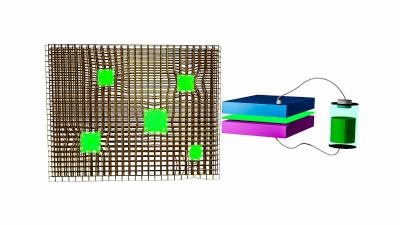 Light-emitting diodes made from perovskite nanocrystals (green) embedded in a metal-organic framework. Image from Phys.org
Light-emitting diodes made from perovskite nanocrystals (green) embedded in a metal-organic framework. Image from Phys.org
Perovskite nanocrystals' unstable nature has so far hindered their potential to be used as LED materials. However, the research team managed to stabilize the nanocrystals in a porous structure called a metal-organic framework, or MOF for short. Based on earth-abundant materials and fabricated at room temperature, these LEDs could one day enable lower cost TVs and consumer electronics, as well as better gamma-ray imaging devices and even self-powered X-ray detectors with applications in medicine, security scanning and scientific research.
Researchers examine the potential of perovskites for next-gen LED-based data communications
Researchers from the University of Surrey and the University of Cambridge have examined how two semiconducting materials can satisfy the telecommunication industry's hunger for huge amounts of data at increasing speeds. Light-emitting diode (LED)-based communications techniques allow computing devices, including mobile phones, to communicate with one another by using infrared light. However, LED techniques are underused because in its current state LED transmits data at far slower speeds than other wireless technologies such as light-fidelity (Li-Fi).
The researchers from Surrey and Cambridge, along with partners from the University of Electronic Science and Technology of China, examine how organic semiconductors, colloidal quantum dots (CQDs) and metal halide perovskites, can be used in LED-based optical communications systems.
Perovskites enable novel light-emitting memory devices
Researchers from National Taiwan Normal University and Kyushu University have developed a new memory device, readable through both electrical and optical methods, that needs only perovskites to simultaneously store and visually transmit data.
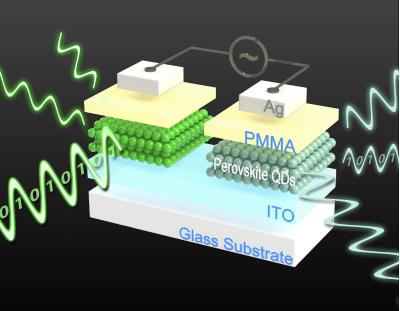 Schematic of the CsPbBr3 QD-based LEM device. Image from Nature Communications
Schematic of the CsPbBr3 QD-based LEM device. Image from Nature Communications
By integrating a light-emitting electrochemical cell with a resistive random-access memory that are both based on perovskite, the team achieved parallel and synchronous reading of data both electrically and optically in a 'light-emitting memory.'
Tip-induced strain engineering of single metal halide perovskite quantum dots
A joint research team, affiliated with Korea's UNIST, has developed a novel method capable of controlling the brightness and wavelength of quantum dots (QDs). The work was led by Professor Kyoung-Duck Park in the Department of Physics at UNIST, in collaboration with Professor Sohee Jeong in the Department of Energy Science from Sungkyunkwan University (SKKU).
The research team demonstrated the tip-induced dynamic control of strain, bandgap, and quantum yield of single CsPbBrxI3'x pQDs by using a controllable plasmonic nanocavity combined with tip-enhanced photoluminescence (TEPL) spectroscopy.
Researchers design efficient germanium-lead perovskite LEDs
A research team, led by Prof. Di Dawei from the Zhejiang University College of Optical Science and Engineering, recently discovered that by using germanium (Ge), an environmentally friendly group-IV element, to partially substitute lead in the perovskite, it is possible to create highly luminescent perovskite materials and devices.
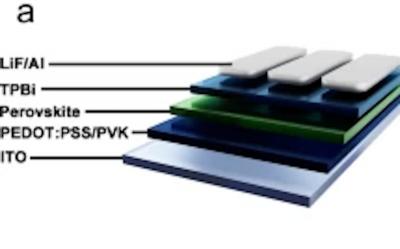 Schematic of the Ge'Pb PeLED device structure. Image from Nature Communications
Schematic of the Ge'Pb PeLED device structure. Image from Nature Communications
To resolve the toxicity problem that arises from the use of lead, an effective method has been the use of tin (Sn) as a partial or full replacement of lead in the perovskite materials. This strategy has been particularly successful for perovskite solar cells. However, tin-based (including tin-lead) perovskite materials are generally very poor light emitters, causing unsatisfactory performance of tin-based perovskite light-emitting devices (LEDs).
New functional materials combine the advantages of 2D materials and hybrid perovskites
A team of researchers from the universities of Marburg, Giessen and Paderborn has combined the advantages of two-dimensional materials and hybrid perovskites, to create new materials to benefit computer chips, light-emitting diodes and solar cells.
The team explains that the development of new two-dimensional materials has, to date, been rather limited to structures with layers of rigid chemical bonds in two spatial directions - like a sheet of paper in a stack. Now, for the first time, the research team led by Dr. Johanna Heine (Inorganic Chemistry, Philipps University of Marburg) has overcome this limitation by using an innovative concept. The researchers developed an organic-inorganic hybrid crystal which consists of chains in a single direction, yet still forms two-dimensional layers in spite of this. This makes it possible to combine different material components, like pieces in a construction set, to create tailored materials with innovative properties.
AMOLF researchers create new ion exchange lithography technique
AMOLF researchers Lukas Helmbrecht and Wim Noorduin have developed a reactive ink that can be painted on an equally reactive canvas. The ink reacts with the material on the canvas to become a semiconductor that emits colored light, an essential part of electronic components such as LEDs.
 Schematic illustration showing the fabrication of a spatially patterned perovskite film. Image from Advanced Materials
Schematic illustration showing the fabrication of a spatially patterned perovskite film. Image from Advanced Materials
The AMOLF team's new ion exchange lithography technique enables one to paint a canvas by making the canvas itself change to a different color instead of brushing paint on it. In this technique, the 'ink' reacts with the 'canvas' by means of ion exchange. To demonstrate the technique, the team used it to airbrush an image of Madame Curie. 'I find it fascinating to see: the green image forms as soon as you start spraying, despite both the ink and the canvas being colorless', said Helmbrecht.
The Perovskite for Displays Market Report updated to April 2021
Perovskite-Info is proud to announce an update to our Perovskite for the Display Industry Market Report. This market report, brought to you by the world's leading perovskite and OLED industry experts, is a comprehensive guide to next-generation perovskite-based solutions for the display industry that enable efficient, low cost and high-quality display devices. The report is now updated to April 2021.
Reading this report, you'll learn all about:
- Perovskite materials and their properties
- Perovskite applications in the display industry
- Perovskite QDs for color conversion
- Prominent perovskite display related research activities
The report also provides a list of perovskite display companies, datasheets and brochures of pQD film solutions, an introduction to perovskite materials and processes, an introduction to emerging display technologies and more.
Pagination
- Previous page
- Page 6
- Next page
